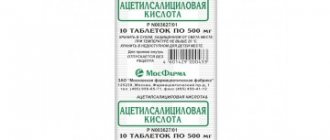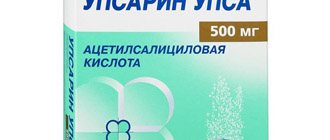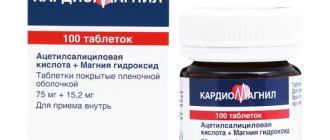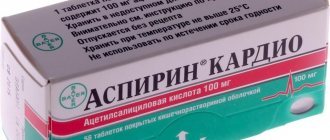ASA tablets po enteric soluble 75 mg No. 10x5
Name
ASA tablet, coated, vol. 75 mg in container pack No. 10x5
Description
Round, biconvex, red, film-coated tablets.
Main active ingredient
Acetylsalicylic acid
Release form
Enteric-coated tablets
Dosage
75 mg
pharmachologic effect
Acetylsalicylic acid inhibits platelet aggregation and also has antipyretic, analgesic and anti-inflammatory effects. Aggregation is inhibited even after using the drug in low doses, the effect persists for several days after taking a single dose. It is believed that acetylsalicylic acid has other mechanisms for suppressing platelet aggregation, which expands the scope of its use in various vascular diseases. Enteric-coated tablets are a pharmaceutical form that does not disintegrate in the stomach, thereby reducing the risk of direct contact of acetylsalicylic acid with the gastric mucosa and its damage. The disintegration of the tablet and the release of the active substance occurs only in the duodenum.
Indications for use
Unstable angina - as part of standard therapy. Acute myocardial infarction - as part of standard therapy. Prevention of recurrent myocardial infarction. Prevention of repeated transient ischemic attack (TIA) and repeated cerebral infarction. Prevention of thrombosis after surgery and invasive vascular interventions (for example, after coronary artery bypass grafting (CABG) or primary percutaneous coronary intervention (PCI)). Prevention of cardiovascular diseases in patients at high risk is possible only as prescribed by a doctor, if the benefit of therapy outweighs the risk of adverse events, in particular bleeding, and it is possible to diagnose hidden bleeding. Note: acetylsalicylic acid in a single dose of 75-150 mg is not intended for the treatment of pain.
Directions for use and doses
- Unstable angina: 75-150 mg once a day.
- Acute myocardial infarction: 75-150 mg once a day.
- Prevention of recurrent myocardial infarction: 300 mg once a day.
- Prevention of repeated transient ischemic attack (TIA) and repeated cerebral infarction: 75-150 mg 1 time per day.
- Prevention of thrombosis after surgery and invasive vascular interventions (for example, after coronary artery bypass grafting (CABG) or primary percutaneous coronary intervention (PCI)): 75-150 mg 1 time per day.
Antiplatelet therapy with acetylsalicylic acid is recommended to begin 24 hours after CABG or PCI surgery.
- Prevention of cardiovascular diseases in patients at high risk (possible only as prescribed by a doctor, if the benefits of therapy outweigh the risk of adverse events): 75 mg 1 time per day.
It is recommended to take acetylsalicylic acid once a day, before meals, with plenty of liquid. In case of acute myocardial infarction, it is recommended to chew the first tablet and drink plenty of water. Acetylsalicylic acid 75 mg (150 mg) is intended for long-term use. The duration of therapy is determined by the doctor.
Use during pregnancy and lactation
Pregnancy Inhibition of prostaglandin synthesis may adversely affect pregnancy and/or embryonic/fetal development. Data from epidemiological studies indicate an increased risk of miscarriage, as well as the development of heart defects and gastroschisis after the use of prostaglandin synthesis inhibitors in early pregnancy. The risk is expected to increase with increasing dose and duration of therapy. Experience in pregnant women using acetylsalicylic acid in daily doses of 50 to 150 mg in the second and third trimesters showed no evidence of decreased uterine tone, increased bleeding, or premature closure of the ductus arteriosus. There are no data on the effect of daily doses of acetylsalicylic acid in the range of 150 and 300 mg during pregnancy. In the first and second trimesters of pregnancy, acetylsalicylic acid can be taken in a daily dose of less than 300 mg, in short courses, only as prescribed by a doctor, after a careful assessment of the benefit-risk ratio for the mother and fetus. In the third trimester of pregnancy, salicylates in high doses (more than 300 mg/day; we are talking about usual doses of acetylsalicylic acid from 500 mg as an anesthetic) can cause inhibition of labor, premature closure of the ductus arteriosus in the fetus, increased bleeding in the mother and fetus, and administration immediately before birth can cause intracranial hemorrhages, especially in premature infants. In the third trimester of pregnancy, acetylsalicylic acid can be taken in a daily dose of less than 150 mg, in short courses, only as prescribed by a doctor, after a careful assessment of the benefit/risk ratio for the mother and fetus. Taking acetylsalicylic acid in a daily dosage of more than 150 mg in the third semester is contraindicated. Breastfeeding Acetylsalicylic acid and its metabolites pass into breast milk in small quantities. Interruption of breastfeeding is usually not required if a daily dose of up to 150 mg is used. When using the drug for a long time or when it is prescribed at a daily dose of more than 150 mg per day, breastfeeding should be stopped.
Impact on the ability to drive vehicles and operate machinery
Taking the drug ASA does not affect the ability to drive a car and/or moving machinery.
Precautionary measures
Caution should be exercised;
- For gout, hyperuricemia, because acetylsalicylic acid in low doses reduces the excretion of uric acid; It should be borne in mind that acetylsalicylic acid in low doses can provoke the development of gout in predisposed patients (those with reduced excretion of uric acid).
- If there is a history of ulcerative lesions of the gastrointestinal tract or gastrointestinal bleeding.
- If liver function is impaired (below class B on the Child-Pugh scale).
- In case of impaired renal function (creatinine clearance more than 30 ml/min), as well as in cases of circulatory disorders resulting from atherosclerosis of the renal arteries, congestive heart failure, hypovolemia, extensive surgery, sepsis, cases of massive bleeding, since in all of these cases acetylsalicylic acid can increase risk of developing acute renal failure and renal dysfunction.
- For bronchial asthma, chronic respiratory diseases, hay fever, nasal polyposis, drug allergies, including NSAIDs (analgesics, anti-inflammatory, antirheumatic drugs).
- In case of proposed surgical intervention (including minor ones, for example, tooth extraction), since acetylsalicylic acid may cause a tendency to develop bleeding for several days after taking the drug.
- For patients who have acute glucose-6-phosphate dehydrogenase (G6PD) deficiency, acetylsalicylic acid may cause hemolysis or hemolytic anemia. Factors that may increase the risk of hemolysis include, for example, high dose, fever or acute infections.
- When used in combination with the following drugs: with methotrexate at a dose of less than 15 mg per week; with anticoagulant, thrombolytic or other antiplatelet agents; with NSAIDs and salicylic acid derivatives in large doses; with digoxin; with hypoglycemic agents for oral administration (sulfonylurea derivatives) and insulin; with valproic acid; with alcohol (alcoholic drinks in particular); with selective serotonin reuptake inhibitors; with ibuprofen (see section “Interaction with other drugs”).
Exceeding the dose of acetylsalicylic acid is associated with the risk of gastrointestinal bleeding. Overdose is especially dangerous in elderly patients. In severe forms of glucose-6-phosphate dehydrogenase deficiency, acetylsalicylic acid can cause hemolysis and hemolytic anemia. Factors that may increase the risk of hemolysis include fever, acute infections, and high doses of the drug. At low doses, acetylsalicylic acid reduces the excretion of uric acid, which can cause attacks of gout in patients predisposed to this disease. Medicines containing acetylsalicylic acid should not be prescribed to children and adolescents for the treatment of viral infections, with or without fever, without consulting a doctor. Some viral illnesses, especially influenza A, influenza B and chickenpox, carry the risk of developing Reye's syndrome, a very rare but life-threatening disease that requires emergency medical attention. This risk may increase with concomitant use of acetylsalicylic acid, however, a cause-and-effect relationship has not been established. A sign of Reye's syndrome can be persistent vomiting in the above diseases. Considering the above, children under 16 years of age are contraindicated in using the drug without appropriate indications (Kawasaki disease).
Interaction with other drugs
When used simultaneously, acetylsalicylic acid enhances the effect of the drugs listed below, therefore, if it is necessary to simultaneously prescribe the drug ASA with the listed drugs, the need to reduce the dose of these drugs should be considered:
- Methotrexate by reducing renal clearance and displacing it from protein binding; the combination of acetylsalicylic acid with methotrexate is accompanied by an increased incidence of side effects from the hematopoietic organs; the use of the drug together with methotrexate is contraindicated if the dose of the latter exceeds 15 mg per week (see section “Contraindications”) and can be used with caution when the dose of methotrexate is less than 15 mg per week.
- Heparin and indirect anticoagulants due to disruption of platelet function and displacement of indirect anticoagulants from protein binding.
- When used simultaneously with anticoagulants, thrombolytic and antiplatelet agents (ticlopidine), there is an increased risk of bleeding as a result of the synergism of the main therapeutic effects of the drugs used.
- When used simultaneously with drugs that have anticoagulant, thrombolytic or antiplatelet effects, an increased damaging effect on the mucous membrane of the gastrointestinal tract is observed.
- Selective serotonin reuptake inhibitors, which may lead to an increased risk of bleeding from the upper gastrointestinal tract (synergism with acetylsalicylic acid).
- Digoxin due to a decrease in its renal excretion, which can lead to an overdose.
- Hypoglycemic agents for oral administration (sulfonylurea derivatives) and insulin due to the hypoglycemic properties of acetylsalicylic acid itself in high doses and displacing sulfonylurea derivatives from communication with blood plasma proteins. This must be kept in mind when prescribing the drug ASA to patients with diabetes mellitus receiving the listed drugs.
- When used simultaneously with valproic acid, its toxicity increases due to displacement from binding with blood plasma proteins.
- NSAIDs and salicylic acid derivatives in high doses (increased risk of ulcerogenic effect and bleeding from the gastrointestinal tract as a result of synergistic action).
- Ethanol (alcoholic drinks) - increased risk of damage to the mucous membrane of the gastrointestinal tract and prolongation of bleeding time as a result of the mutual enhancement of the effects of acetylsalicylic acid and ethanol.
The simultaneous administration of acetylsalicylic acid in high doses may weaken the effect of the drugs listed below. If it is necessary to simultaneously prescribe the drug ASA with the listed drugs, you should consider the need to adjust the dose of the drugs listed below:
- Any diuretics (when used together with acetylsalicylic acid in high doses, a decrease in glomerular filtration rate is observed as a result of a decrease in the synthesis of prostaglandins in the kidneys).
- Angiotensin-converting enzyme (ACE) inhibitors (a dose-dependent decrease in glomerular filtration rate (GFR) is noted as a result of inhibition of prostaglandins that have a vasodilatory effect, respectively, weakening of the hypotensive effect. The clinical significance of the decrease in GFR is noted with a daily dose of acetylsalicylic acid more than 160 mg. In addition, there is a decrease in the positive cardioprotective effect of ACE inhibitors prescribed to patients for the treatment of chronic heart failure. This effect is also manifested when used in conjunction with acetylsalicylic acid in high doses).
- Medicines with uricosuric action - benzbromarone, probenecid (reduced uricosuric effect due to competitive suppression of renal tubular excretion of uric acid).
When used simultaneously with ibuprofen, antagonism is observed in relation to irreversible platelet inhibition caused by the action of acetylsalicylic acid, which leads to a decrease in the cardioprotective effects of acetylsalicylic acid. Therefore, the combination of the drug ASA with ibuprofen is not recommended in patients with an increased risk of cardiovascular disease. When used simultaneously with systemic glucocorticosteroids (GCS) (with the exception of hydrocortisone or other GCS used for replacement therapy of Addison's disease), there is an increase in the elimination of salicylates and, accordingly, a weakening of their effect. When using GCS and salicylates in combination, it should be remembered that during treatment the level of salicylates in the blood is reduced, and after discontinuation of GCS, an overdose of salicylates is possible.
Contraindications
Hypersensitivity to acetylsalicylic acid, excipients in the composition of the drug. Bronchial asthma induced by salicylates and other NSAIDs. Erosive and ulcerative lesions of the gastrointestinal tract (in the acute stage). Gastrointestinal bleeding. Hemorrhagic diathesis. Combined use with methotrexate at a dose of 15 mg per week or more. Pregnancy (III trimester) with a daily dose of more than 150 mg. Severe renal failure (creatinine clearance (CC) less than 30 ml/min). Severe liver failure (class B and higher on the Child-Pugh scale). Chronic heart failure of functional class III-IV according to the NYHA classification.
Compound
Each tablet contains: active substance: acetylsalicylic acid - 75 mg or 150 mg; excipients: modified corn starch, stearic acid, microcrystalline cellulose. shell composition: Aquarius Prefered® (hypromellose, copovidone plasdon, polyethylene glycol, polydextrose, titanium dioxide, caprylic/capric acid triglyceride, yellow iron oxide E 172), Acrylic-IZ® (copolymer of methacrylic acid and ethyl acrylate, talc, ponceau 4 R E 124 , triethyl citrate, titanium dioxide, anhydrous colloidal silicon dioxide, sodium bicarbonate, sodium lauryl sulfate, sunset yellow E 110, indigo carmine E 132).
Overdose
Salicylate intoxication (develops when taking acetylsalicylic acid at a dose of more than 100 mg/kg/day for more than 2 days) can result from prolonged use of toxic doses of the drug as part of improper therapeutic use of the drug (chronic intoxication) or a single accidental or intentional use toxic dose of a drug in an adult or child (acute intoxication). Symptoms of chronic intoxication with salicylic acid derivatives are nonspecific and are often difficult to diagnose. Mild intoxication usually develops only after repeated use of large doses of the drug and is manifested by dizziness, tinnitus, hearing loss, increased sweating, nausea and vomiting, headache and confusion. These symptoms disappear after reducing the dose of the drug. Tinnitus may appear when the concentration of acetylsalicylic acid in the blood plasma is from 150 to 300 mcg/ml. More severe symptoms appear when the concentration of acetylsalicylic acid in the blood plasma is above 300 mcg/ml. The main manifestation of acute intoxication is a severe disturbance of the acid-base state, the manifestations of which may vary depending on the age of the patient and the severity of intoxication. In children, the most typical development is metabolic acidosis. Treatment of intoxication is carried out in accordance with accepted standards and depends on the severity of intoxication and the clinical picture and should be aimed mainly at accelerating the elimination of the drug and restoring the water-electrolyte balance and acid-base state. Symptoms of overdose are mild to moderate: dizziness, tinnitus, hearing loss, increased sweating, nausea, vomiting, headache, confusion, profuse sweating, tachypnea, hyperventilation, respiratory alkalosis. Treatment: gastric lavage, repeated intake of activated carbon, forced alkaline diuresis, restoration of water-electrolyte balance and acid-base state. Symptoms of moderate to severe overdose:
- respiratory alkalosis with compensatory metabolic acidosis;
- hyperpyrexia (extremely high body temperature);
- respiratory disorders: hyperventilation, non-cardiogenic pulmonary edema, respiratory depression, asphyxia;
- disorders of the cardiovascular system: cardiac arrhythmias, arterial hypotension, cardiac depression;
- disturbances of water and electrolyte balance: dehydration, impaired renal function from oliguria up to the development of renal failure, characterized by hypokalemia, hypernatremia, hyponatremia;
- impaired glucose metabolism: hyperglycemia, hypoglycemia (especially in children), ketoacidosis;
- tinnitus, deafness;
- gastrointestinal bleeding;
- hematological disorders: from inhibition of platelet aggregation to coagulopathy, prolongation of prothrombin time, hypoprothrombinemia;
- neurological disorders: toxic encephalopathy and depression of central nervous system function (drowsiness, confusion, coma, convulsions).
Treatment: immediate hospitalization in specialized departments for emergency treatment - gastric lavage, repeated intake of activated charcoal, forced alkaline diuresis, hemodialysis, restoration of water-electrolyte balance and acid-base status, symptomatic therapy.
Side effect
To assess the frequency of side effects, the World Health Organization classification is used: very often (> 1/10), often (> 1/100, 1/1000, 1/10000,
Storage conditions
Store in a place protected from moisture and light at a temperature not exceeding 25 °C. Keep out of the reach of children.
Buy ASA tablets p/o enteric soluble 75 mg No. 10x5 in the pharmacy
Price for ASA tablets p/o enteric soluble 75 mg No. 10x5
Instructions for use for ASA tablets p/o enteric soluble 75 mg No. 10x5
Aspirin Cardio tablets solution/intestinal 100 mg No. 28
Interaction
When used simultaneously, antacids containing magnesium and/or aluminum hydroxide slow down and reduce the absorption of acetylsalicylic acid.
With the simultaneous use of calcium channel blockers, drugs that limit the intake of calcium or increase the excretion of calcium from the body, the risk of bleeding increases.
When used simultaneously with acetylsalicylic acid, the effect of heparin and indirect anticoagulants, hypoglycemic agents, sulfonylurea derivatives, insulins, methotrexate, phenytoin, and valproic acid is enhanced.
When used simultaneously with GCS, the risk of ulcerogenic effects and gastrointestinal bleeding increases.
With simultaneous use, the effectiveness of diuretics (spironolactone, furosemide) decreases.
With the simultaneous use of other NSAIDs, the risk of side effects increases. Acetylsalicylic acid may reduce plasma concentrations of indomethacin and piroxicam.
When used simultaneously with gold preparations, acetylsalicylic acid can induce liver damage.
With simultaneous use, the effectiveness of uricosuric drugs (including probenecid, sulfinpyrazone, benzbromarone) is reduced.
With the simultaneous use of acetylsalicylic acid and sodium alendronate, severe esophagitis may develop.
With simultaneous use of griseofulvin, the absorption of acetylsalicylic acid may be impaired.
A case of spontaneous hemorrhage into the iris was described when taking Ginkgo biloba extract during long-term use of acetylsalicylic acid at a dose of 325 mg/day. It is believed that this may be due to an additive inhibitory effect on platelet aggregation.
With simultaneous use of dipyridamole, an increase in Cmax of salicylate in blood plasma and AUC is possible.
When used simultaneously with acetylsalicylic acid, the concentrations of digoxin, barbiturates and lithium salts in the blood plasma increase.
With the simultaneous use of salicylates in high doses with carbonic anhydrase inhibitors, salicylate intoxication is possible.
Acetylsalicylic acid in doses less than 300 mg/day has a minor effect on the effectiveness of captopril and enalapril. When using acetylsalicylic acid in high doses, the effectiveness of captopril and enalapril may be reduced.
With simultaneous use, caffeine increases the rate of absorption, plasma concentration and bioavailability of acetylsalicylic acid.
With simultaneous use, metoprolol may increase the Cmax of salicylate in the blood plasma.
When using pentazocine against the background of long-term use of acetylsalicylic acid in high doses, there is a risk of developing severe adverse reactions from the kidneys.
With simultaneous use, phenylbutazone reduces uricosuria caused by acetylsalicylic acid.
With simultaneous use, ethanol may enhance the effect of acetylsalicylic acid on the gastrointestinal tract.
ASK-cardio tablet p/o intestinal solution. 100 mg 60 pcs
Pharmacological group:
Antiplatelet agent ATC code: B01AC06
Pharmacodynamics:
Acetylsalicylic acid (ASA) is an ester of salicylic acid and belongs to the group of non-steroidal anti-inflammatory drugs (NSAIDs). The mechanism of action is based on the irreversible inactivation of the enzyme cyclooxygenase (COX-1), as a result of which the synthesis of prostaglandins, prostacyclins and thromboxane is blocked. Reduces platelet aggregation, adhesion and thrombus formation by suppressing the synthesis of thromboxane A2 in platelets. Increases the fibrinolytic activity of blood plasma and reduces the concentration of vitamin K-dependent coagulation factors (II, VII, IX, X). The antiplatelet effect develops after the use of small doses of the drug and persists for 7 days after a single dose. These properties of ASA are used in the prevention and treatment of myocardial infarction, coronary heart disease, and complications of varicose veins. ASA also has anti-inflammatory, antipyretic and analgesic effects.
Pharmacokinetics:
After oral administration, ASA is quickly and completely absorbed from the gastrointestinal tract (GIT). ASA is partially metabolized during absorption. During and after absorption, ASA is converted to its main metabolite, salicylic acid, which is metabolized primarily in the liver under the influence of enzymes to form metabolites such as phenyl salicylate, glucuronide salicylate and salicyluric acid, found in many tissues and in the urine. In women, the metabolic process is slower (less enzyme activity in the blood serum). The maximum concentration of ASA in the blood plasma is achieved 10-20 minutes after oral administration, salicylic acid - after 0.3-2 hours. Due to the fact that the tablets are coated with an acid-resistant coating, ASA is not released in the stomach (the coating effectively blocks the dissolution of the drug in the stomach), but in the alkaline environment of the duodenum. Thus, the absorption of ASA in the form of enteric-coated tablets is delayed by 3-6 hours compared to conventional (without such a coating) tablets.
ASA and salicylic acid are highly bound to plasma proteins (from 66% to 98% depending on the dose) and are quickly distributed in the body. Salicylic acid crosses the placenta and is secreted into breast milk.
The elimination of salicylic acid is dose-dependent, since its metabolism is limited by the capabilities of the enzymatic system. The half-life ranges from 2-3 hours when using ASA in low doses and up to 15 hours when using the drug in high doses (usual doses of acetylsalicylic acid as an analgesic). Unlike other salicylates, with repeated administration of the drug, non-hydrolyzed ASA does not accumulate in the blood serum. Salicylic acid and its metabolites are excreted by the kidneys. In patients with normal renal function, 80-100% of a single dose of the drug is excreted by the kidneys within 24-72 hours.
ASK-cardio® (ASK-cardio®)
When used simultaneously, ASA enhances
the effect of the following medications; If it is necessary to use ASA simultaneously with the listed drugs, the need to reduce the dose of drugs should be considered:
- methotrexate, by reducing renal clearance and displacing it from protein binding;
- when used simultaneously with anticoagulants, thrombolytic and antiplatelet agents (ticlopidine, clopidogrel), there is an increase in the risk of bleeding as a result of the synergism of the main therapeutic effects of the drugs used;
- when used simultaneously with drugs that have anticoagulant, thrombolytic or antiplatelet effects, there is an increased damaging effect on the mucous membrane of the gastrointestinal tract;
- selective serotonin reuptake inhibitors, which may lead to an increased risk of bleeding from the upper gastrointestinal tract (synergism with ASA);
- digoxin, due to a decrease in its renal excretion, which can lead to an overdose;
— hypoglycemic agents for oral administration (sulfonylurea derivatives) and insulin due to the hypoglycemic properties of ASA itself in high doses and displacing sulfonylurea derivatives from binding with blood plasma proteins;
- when used simultaneously with valproic acid, its toxicity increases due to the displacement of its connection with blood plasma proteins;
- NSAIDs and salicylic acid derivatives in high doses (increased risk of ulcerogenic effect and bleeding from the gastrointestinal tract as a result of synergistic action); when used simultaneously with ibuprofen, antagonism is observed in relation to irreversible platelet inhibition caused by the action of ASA, which leads to a decrease in the cardioprotective effects of ASA;
— Ethanol (increased risk of damage to the mucous membrane of the gastrointestinal tract and prolongation of bleeding time as a result of the mutual enhancement of the effects of ASA and ethanol);
— With the simultaneous use of acetylsalicylic acid (as an antiplatelet agent) and blockers of “slow” calcium channels, the risk of bleeding increases;
— When used simultaneously with gold preparations, acetylsalicylic acid can induce liver damage.
With simultaneous use of ASA in high doses, it weakens
the effect of the drugs listed below; If it is necessary to simultaneously prescribe ASA with the listed drugs, the need to adjust the dose of the listed drugs should be considered:
- any diuretics (when used together with ASA in high doses, a decrease in glomerular filtration rate (GFR) is observed as a result of a decrease in the synthesis of prostaglandins in the kidneys);
- angiotensin-converting enzyme (ACE) inhibitors (a dose-dependent decrease in GFR is noted as a result of inhibition of prostaglandins that have a vasodilatory effect, respectively, a weakening of the hypotensive effect. A clinical decrease in GFR is observed with a daily dose of ASA more than 160 mg. In addition, there is a decrease in the positive cardioprotective effect of ACE inhibitors, prescribed to patients for the treatment of chronic heart failure. This effect is also manifested when used in conjunction with ASA in large doses);
- drugs with uricosuric action - benzbromarone, probenecid (reduced uricosuric effect due to competitive suppression of renal tubular excretion of uric acid);
- when used simultaneously with systemic glucocorticosteroids (with the exception of hydrocortisone used for replacement therapy of Addison's disease), there is an increase in the excretion of salicylates and, accordingly, a weakening of their effect.
Antacids containing magnesium and/or aluminum slow down and impair the absorption of acetylsalicylic acid.





